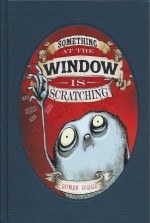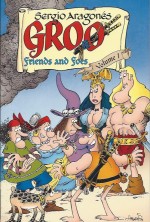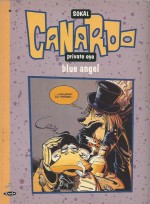
By Laudec & Cauvin with colours by Leonardo and translated by Erica Jeffrey (Cinebook)
ISBN: 978-1-905460-68-7
Raoul Cauvin is one of Europe’s most successful comics scripters. Born in Antoing, Belgium in 1938, he joined Dupuis’ animation department in 1960 after studying the dying and much-missed print production technique of Lithography.
Happily he quickly discovered his true calling Рcomedy writing Рand began a glittering and prolific career at Spirou where he devised (with Salv̩rius) the astoundingly successful Bluecoats as well as dozens of other long-running, award winning series such as Sammy, Les Femmes en Blanc, Boulouloum et Guiliguili, Cupidon, Pauvre Lampil and Agent 212: cumulatively shifting more than 240 separate albums. Bluecoats alone has sold more than 15 million copies so far.
His collaborator on kid-friendly family strip Cedric is Italian born, Belgium raised Tony de Luca who studied electro-mechanics and toiled as an industrial draughtsman until he could make the break into comics.
After a few fanzine efforts in the late 1970s, in 1979 as Laudec he landed soap-style series Les Contes de Curé-la-Fl’ûte at Spirou and built it into a brace of extended war-time serials (L’an 40 in 1983 and Marché Noir et Bottes à Clous in 1985) whilst working his way around many of the title’s other strips.
In 1987 he united with Cauvin on the first Cédric shorts and the rest is history… and science and geography and PE and…
We have Dennis the Menace and the Americans have one too – but he’s not the same – whilst the French-speaking world has Cédric: a charming little rapscallion with a heart of gold and an irresistible streak of mischief dogging his heels. Collected albums of the short, sharp strips – ranging from a ½ page to half a dozen – began appearing in 1989 (with 29 released so far) and are always amongst the most popular and best-selling on the continent, as is the animated TV show spun off from the strip.
This first Cinebook translation – from 2008 and originally continentally released as Classe tous risques in 1990 – was the third compilation and hauls straight in to the action as the little lout is surprised by the introduction of ‘The New Girl’ to the class.
Previously, overly-imaginative Cedric had been utterly enamoured of his teacher Miss Nelly but when Chen is introduced his mind and heart go into fantasy overdrive. She’s different, her skin isn’t the same colour as everybody else’s and she talks really funny.
Of course a proper gentleman would have a better and less dangerous way of saying that to a newcomer’s face. Happily, however, Cedric’s gaffe is an opportunity for demure but feisty Chen to properly break the ice…
When the restless lad and his best friend Christian get hold of some stink bombs an awful lot of surprised adults are forced to cry ‘What Stinks?’ but the peewee pranksters eventually go too far and are trapped in their own efforts, whereas when Cedric attempts to cheat in a geography competition involving ‘Balloons’ the repercussions are all on him alone…
His deviltry actually succeeds with no comeback when he sabotages the ‘Olympic Disciplines’ of excessively keen Games Master Mr Oliver but when Cedric tries to obscure his latest bad report card by getting injured and crying for ‘Nurse Mum’ his tactics are sorely mistaken…
There’s more social angst – and unleashed aggression – in store when Christian confuses Chinese Chen with Vietnamese ‘Boat People’ and shares his “expertise†with our gullible star but the boys are soon pals again and summarily run amok with a radio-controlled car in ‘Driving Under the Influence of Laughter’ after which Grandpa lands in the doghouse when Cedric steals his champagne and gets disastrously hammered on his ‘First Sip’…
Disclosing he is over Miss Nelly, the love-struck lad goes completely over the top with ‘The Gift’ he has chosen to win Chen, which leads to near disaster when he manfully decides he must let his deserted older woman down gently in ‘One Love Follows Another…’
Typically, Cedric picks the very moment after his teacher has received some extremely upsetting news…
Focus satirically switches to conservative, reactionary Grandpa who takes the news that Cedric is seeing a Chinese girl with an appalling lack of understanding, taste or decorum in ‘The Oil Can’ but it’s the boy who’s soon back in everyone’s bad books when he swaps suntan oil for toothpaste in ‘Bathing Beauties’.
At least his classmates still respect him, especially Freddy who needs all the escape tips he can get after delivering ‘The Report’ of his latest scholastic disgraces to his own furious father whilst Cedric’s family are subjected to cruel and unusual punishment when neighbours ‘Crazy for Television’ invite themselves over…
This introductory album hilariously concludes as Cedric decides to use a school ‘Picnic’ to tell Chen of his feelings, despite the sustained mockery of his mates. Of course his courage is no substitute for discretion or tact and when he goes too far again, at least the boys are there to console and medicate him…
Rapid-paced, warm and witty, the adventures of this painfully keen, young romantic scallywag are a charming example of how all eight year boys are just the same and infinitely unique. This is a solid family-oriented comics book no one trying to introduce youngsters to the medium should be without.
© Dupuis 1990 by Cauvin & Laudec. All rights reserved. English translation © 2008 Cinebook Ltd.












